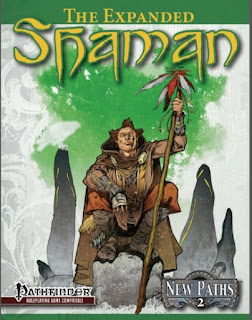The second entry on Open Design’s New Path
series is the Expanded Shaman. This new class for Pathfinder was introduced on
Kobold Quarterly #21 as a new spontaneous divine spellcaster. You can say
that the Shaman is to Druid as the Oracle is to the Cleric. Besides, the
concept of a primitive spellcaster that communes with spirits is so universal
that I always found weird that it hasn’t showed up before in a Paizo product.
Mechanically speaking, the Shaman mirrors the
Druid, including using the same spell list (although limited by the Spells
Known to each Shaman). Instead of an animal companion, Shamans gain an Animal
Spirit Guide (with its own progression table). It gains the ability to commune
with spirits (a.k.a. divinations), besides other neat tricks like the
incorporeal subtype and fast healing – all at higher levels.
Like most Pathfinder classes, the Shaman has a
plethora of special abilities that must be chosen, easily customizing each
character. These abilities are described by the Totem Secret class feature and
cover things like blood divination, speak with animals, spirit sight (including
seeing in the astral and ethereal planes), summon spirits etc. Shamans also
gain a limited amount of healing and can wild shape. Other iconic powers
associated with the archetype are spirit dance (with booster the Shaman’s
spells) and vision quest (treated here as astral projection). Curiously, vision
quest isn’t a benchmark ability (it’s gained at 19th level) and the
Shaman doesn’t gain a new trick at 20th level, besides the ability
to use his spirit dance unlimited.
Expanded Shaman doesn’t stop at the class,
providing new class archetypes: Elemental Shaman, Primal Shifter and the
classic Witch Doctor. We also get 3 new spells, 4 feats and a personalized
character sheet for your wild shape and animal guide.
My augury? The class is really traditional,
following a “by the number” rules structure and refereeing to spells well
consolidated in Pathfinder/D&D 3.5 – and I must say that, in this case, I
loved it! It’s amazingly easily to use, to integrate in any game and it doesn’t
conflict with any cosmology (shamans usually come with a “Spirit World bonus plane”… something that not all Gamemaster are
found of). Finally: it plays like other Core and Base Classes. In other words:
it feels like something Paizo would have written. Do I need to say more?


No comments:
Post a Comment